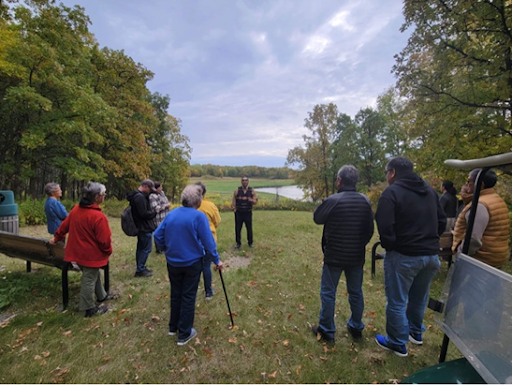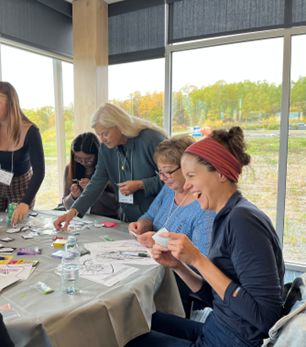By Pamela Klassen, Art Hunter, Krista Barclay, & Teagan de Laronde
With eagles circling over the river and the northern lights dancing at night, the Manitou Mounds hosted a gathering of over fifty people, including many GRASAC members, on the weekend of October 1-2. The Kay-Nah-Chi-Wah-Nung Gathering brought together Elders, community members from Rainy River First Nations, regional museum curators, and university researchers to discuss Treaty #3—its stories and history, how it is remembered and commemorated, and how we honour it today and into the future.
A gathering place for thousands of years, the Manitou Mounds along Manidoo Ziibi (Rainy River) are now stewarded by the Rainy River First Nations through the Kay-Nah-Chi-Wah-Nung Historical Centre. The gathering was opened on Saturday morning in the beautiful Kay-Nah-Chi-Wah-Nung Roundhouse, with songs from Murray Bombay and his drum group and words from Elder Robert Greene of Iskatewizaagegan No. 39 Independent First Nation (Shoal Lake Band No. 39). Elder Greene’s stories of the drum as a reminder of treaties between the Dakota and the Anishinaabe would be of special interest to GRASAC members.
It was a great honour to have Ogichidaa Francis Kavanaugh, Grand Chief of Grand Council Treaty #3, share with us his knowledge about the spirit and intent of Treaty #3, including its revitalization through the Manito Aki Inakonigaawin, or Great Earth Law. This law was ratified and brought through ceremony by Elders at Kay-Nah-Chi-Wah-Nung in 1997, so it was especially powerful to listen to Ogichidaa Kavanaugh reflect on its significance while in the Roundhouse.

The gathering featured a tour of the ancient mounds along the river, and conversation circles focused on aadizookwewigamig and treaty reminders, nibi (water), wajiwanan (mounds), and repatriation and museum relationships. GRASAC members Alan Corbiere, Mikinaak Migwans, Cara Krmpotich, Maureen Matthews, Pamela Klassen, and Krista Barclay all participated in conversations.Additional conversations were led by Art Hunter, Edward Mandamin, Brittany Luby, Lori Nelson, Kayleigh Spiers, and Audrey Rochette. The conversations continued over meals, featuring walleye, bannock, and tacos from the legendary cooks at Hungry Hall.

A particular highlight of the weekend was the community drop-in, held in the Drum Room of the new Rainy River First Nations Band Office building. With a beading station, Anishinaabemowin resources, post-secondary resources, a display of various Treaty 3 projects, and a crowd-pleasing raffle, the event was a huge success with its goal of connecting community work to various community audiences. The display of GRASAC Mobile Community Kits was also popular. We were particularly grateful to Elder Dorothy Medicine and her daughter Gwen for taking some of us on a walk by the river to share stories and knowledge.

| With representation from several regional museums like The Muse in Kenora, Manitoba Museum, Fort Frances Museum, and universities including University of Guelph, York University, and Trent University, the gathering was a great opportunity for many people to visit Kay-Nah-Chi-Wah-Nung for the first time. It was also an excellent step to building networks and connections for future projects and collaborations. As the organizers, we are so grateful to everyone who attended and shared their work, experiences, and insights. The support of Kay-Nah-Chi-Wah-Nung Historical Centre and its wonderful staff, and University of Toronto students Christina Pasqua, Kate Stoehr and Amy Zhao was essential to making it a success. This event was also supported by the Social Sciences and Humanities Research Council of Canada, the Ministry of Colleges and Universities, and the University of Toronto.You can learn more about the gathering from the coverage of the event in the Fort Frances Times, or through participant reflections that will be posted on our Treaty Conversations website in the coming weeks. Chi-Miigwech! |

[…] Kay-Nah-Chi-Wah-Nung Gathering, by Pamela Klassen, Art Hunter, Krista Barclay, & Teagan de Laron… […]